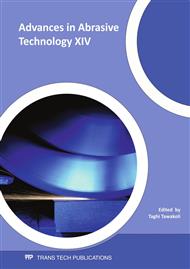p.570
p.576
p.582
p.588
p.594
p.600
p.606
p.621
p.627
Study on Surface Roughness in Micro End Milling of Mold Material
Abstract:
The effects of cutting conditions on the surface roughness in a micro-end-milling process of a mold material are described in this paper. Micro-end-milling operations were performed under different cutting conditions such as feed rate and depth of cut, in order to investigate the factors that had the greatest influence on the finished surface during micro-end-milling. It was revealed that the surface roughness begins to deteriorate when the radial depth of the cut exceeds the tool radius. In addition, it was found that this phenomenon is peculiar to micro-end-milling processes.
Info:
Periodical:
Pages:
594-599
Citation:
Online since:
August 2011
Authors:
Price:
Сopyright:
© 2011 Trans Tech Publications Ltd. All Rights Reserved
Share:
Citation:


